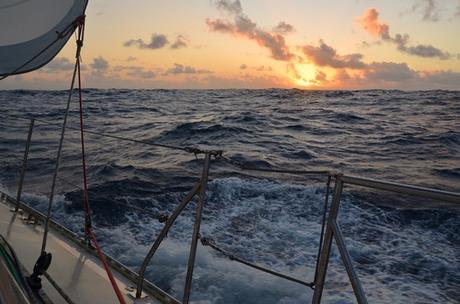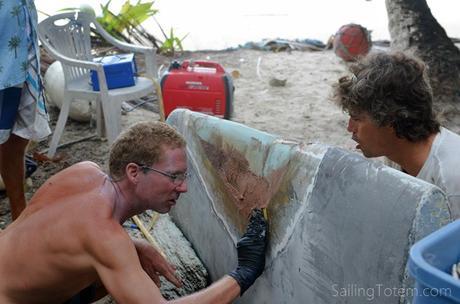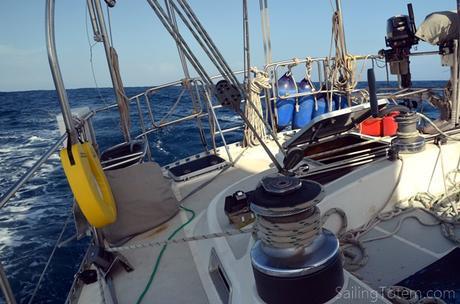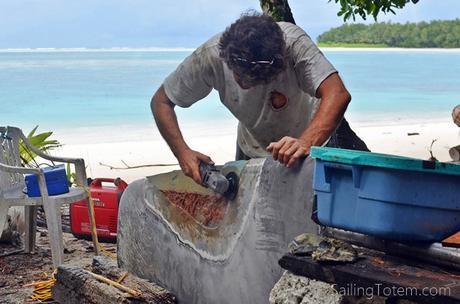
We strive to be a green boat, and supply our power through sun and wind as much as possible. But the wants of five people can outstrip what our solar panels and wind turbine provide, especially during a time of gray skies or equatorial calms. Unfortunately, we had periods of cloudy skies and not much wind while we were in Southeast Asia, and our green power struggled to keep up.

Even though we had much better conditions for solar/wind power with last year’s tradewind sailing, I’m still very glad we picked up a portable generator back in Malaysia. We’re often able to go weeks at a time without running it at all, but can then face weeks where we run it every few days to keep battery voltage up. We’ve also done other modifications to reduce our power consumption, such as rebuilding Totem’s refrigeration box, a move that saved us roughly 75 amp hours/ day. All our interior lights and navigation lights have been switched over to LED, and our new radar doesn’t need an additional display- we just overlay it on the already-running laptop with OpenCPN. But net-net, the generator is a welcome addition when green energy comes up short.
Sometimes, it’s handy to have generator to help with other tools on board. AC devices often require huge DC power, then inverted to AC in order to run. So if running for any length of time we switch on the generator. This is the case with some of Jamie’s power tools and our hooka underwater breather rig.

Inboard vs portable
Everything on a boat is a tradeoff. Inboard gensets are typically quieter, more efficient, cleaner burning, and are safely stowed below. On the other hand, inboards are more mechanically complex, and thus more difficult to service or repair when it is inevitably necessary. They’re more expensive and take up more space. And, of course, you can’t take them to the beach!
It turns out that portability can come in extremely handy. When we assisted with the rescue of Pipistrelle in Chagos last year, Totem’s little Honda 2000 generator powered the grinder and sanders used for repairs on a remote beach. This allowed Jamie and Evan to rebuild the extensively damaged rudder of the Wauquiez 48, so it could sail 1000+ miles for more complete repairs- you can see the red generator in the background of the photo above.
Most of the time, it sits on our aft deck. If away from Totem for a longer stretch (watching lions in Africa!) and concerned about security, Jamie stows it in the main cabin with the fuel tank run dry. For the most part, a drab cover and chain/lock help keep it from being a red beacon on deck to petty thieves.
Basic setup
We really don’t like having “stuff” on deck, but this is a very small footprint and out of the way. Jamie made a simple cover from Sunbrella scraps to protect it from the elements. At the exhaust, he made a pooched opening, so that if it starts to rain while the generator is running it’s possible to turn-off and cover it immediately without having fabric over the hot metal.

where’s waldo? there’s a generator hiding in this picture
Marinizing
Jamie took a few steps to help make the generator a little more marine-friendly.
First, he removed the exhaust “pipe” (he promises it’s easy) and painted with several coast of high-heat, rust-resistant paint. This was based on other cruisers with reporting that the exhaust will rust out every couple years. Our generator is about two years old now and with not notable rust on exhaust.
Not so easy is putting Tefgel or lanocote on the threads of all fasteners holding the housing…but you’ll be glad you made the effort later. We didn’t and had to remove the housing and found some of the fasteners frozen in place.
He recommends using BoeShield or CRC Soft Seal (great stuff!) to provide a protective layer on surface metal. That’s every housing screw-head, the little metal bits underneath the rubber feet, and even metal in the control face. You could probably use it on just about every metal bit on the generator except for the muffler, which gets too hot.
Fueling
Adding gas from a typical jerry can is cumbersome, so use a smaller can to decant. A handy trick is to get one that’s the same size as the tank capacity, to take the guesswork out of the fuel level. It’s not easy to tell, and easy to spill from overfilling.
After too many experiences with bad fuel, we always pour fuel through a Teflon filter to remove impurities. It might seem like a pain but it’s really a simple step, and if your filter is a funnel to facilitate filling, there’s really no extra effort.
Maintenance
Changing the oil is a hassle! It’s simply a bad design. We put a wide funnel in a waste oil can, lift the unit (awkward!) and pour it in… splat mat required. It might be possible to change the oil with an extraction pump; we haven’t tried (the pump we use for engine oil changes is about 10x the necessary capacity). If anyone has better ideas on how to deal with this… please share your thoughts!
Spares
The pull cord doesn’t have a fair lead internally… another poor design. Over time, it chafes through (our original cord lasted about one year). Keep spare line to use for pull cord so you don’t get caught by surprise. The best option we had on hand at the time was some spare leech line, which only lasted a couple of months: 2 – 3 mil Dyneema is the best because of its natural slipperiness.
Issues
The Honda 2000 on one boat we know was behaving erratically: sometimes it started, sometimes it didn’t. After a fair bit of mucking about (and spending money with a mechanic) they determined it was a known defect in the oil sensors. It’s triggered by events like tilting, something that happens now and then on most cruising boats! Personal and broad second hand knowledge suggests that these machines take much abuse and still run – if you find starting to be troublesome, it may be the oil sensor. There is a simple work around by snipping the sensor wire (sort of like defusing a bomb!)
It’s a winner
I grudgingly admit it. As much as I’d love to be an all-green-power boat, our carbon footprint is very small, and the generator is a great addition to Totem. Still, Jamie has more ideas on being greener that will be fun to experiment when well stocked chandlaries/ hardware stores are in close proximity.
This post is syndicated on Sailfeed.


